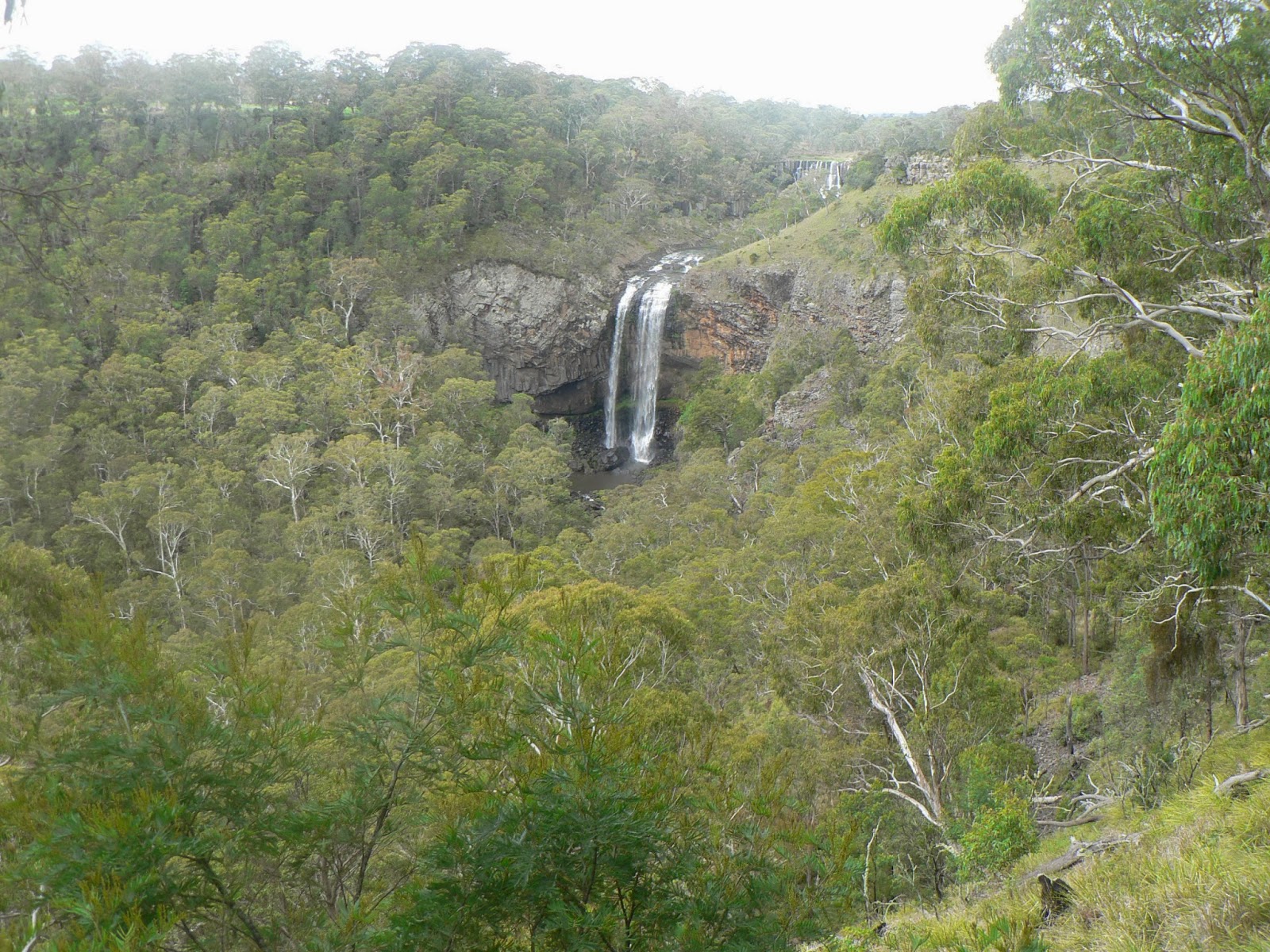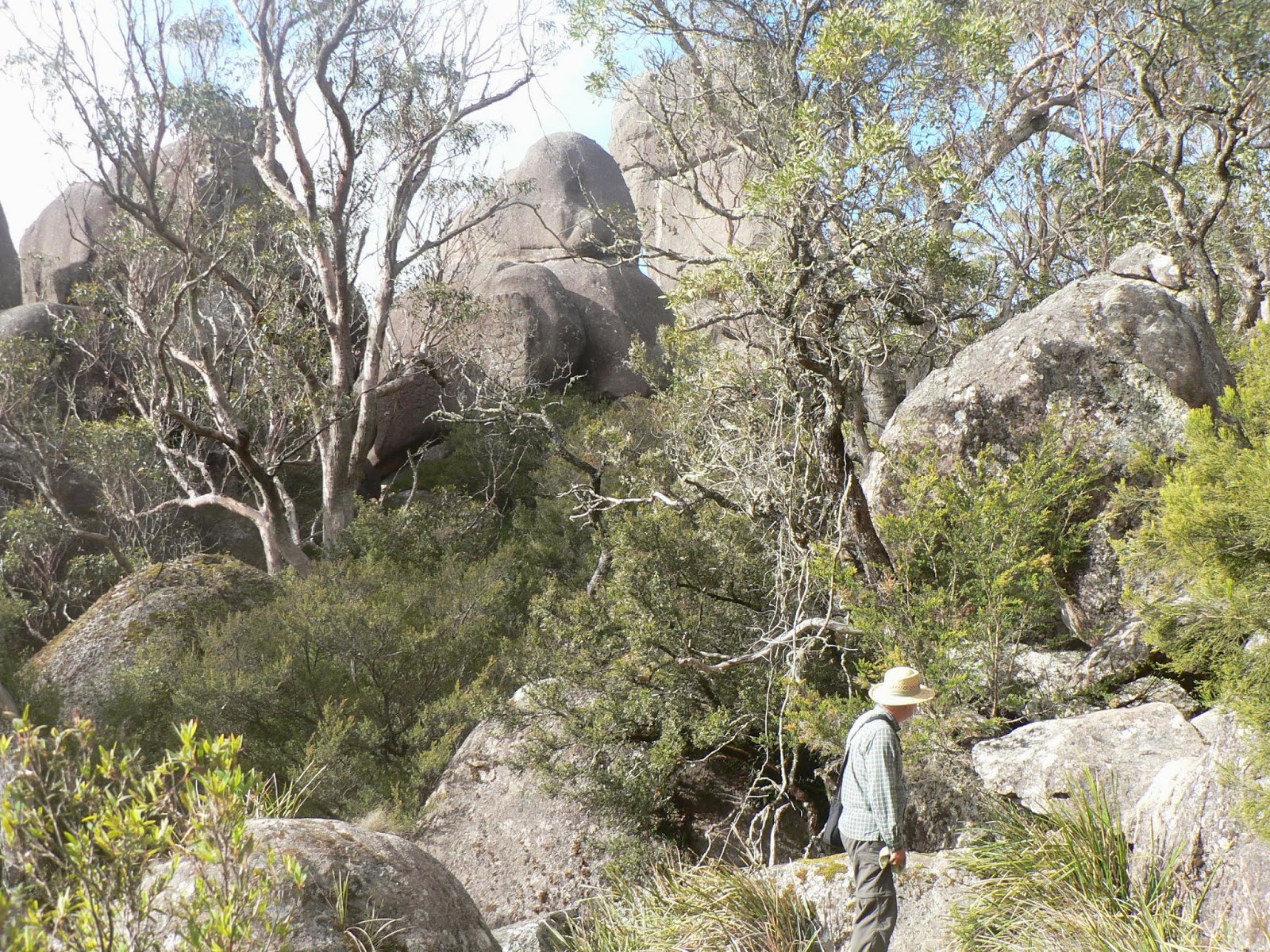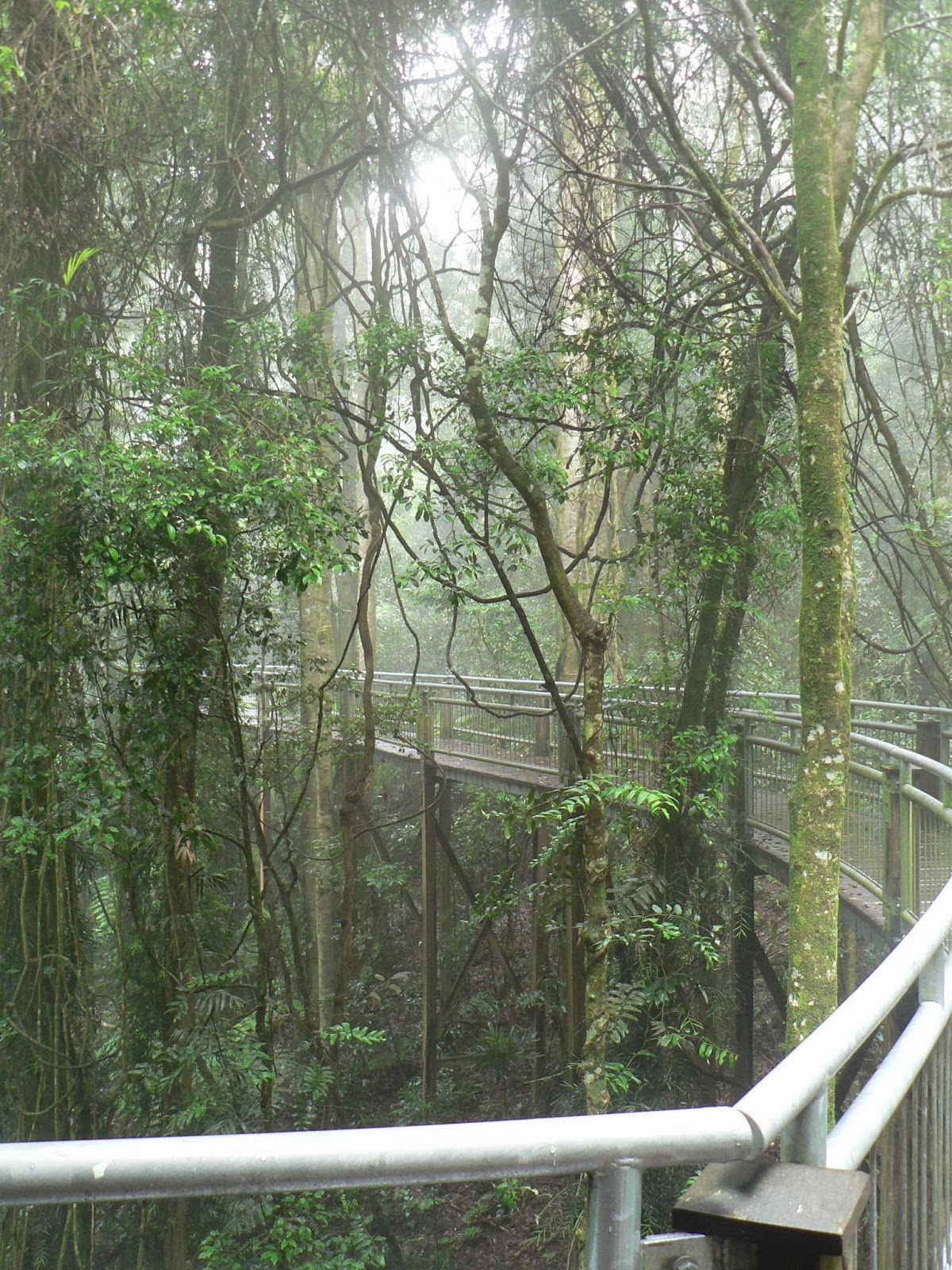 |
| The statue of Captain Thunderbolt In Uralla He was a famous bushranger, shot dead in 1870 and buried in Uralla. |
 |
| Camping at Dangars Falls |
 |
| Dangars Falls |
 |
| Visitors at our camp |
 |
| The Mihi gorge |
 |
| The Anglican Church, Armidale |
 |
| The Mall, Armidale |
 |
| Inside the historic Booloomonbah mension, now part of the University of New England |
 |
| St Patrick Orphanage, Armidale, now a private residence |
 |
| The Wollomombee river |
Saturday, 8 March. We followed the Waterfall Way to the East. Our next stop was Wollomombee Falls, about 50 km from Armidale. This is the tallest waterfall in NSW, more than 200 m - that is, when there is any water in it, which was not the case now. But the gorge was amazing enough even without water. We walked around the rim to several lookouts to appreciate the views from every possible angle.
 |
| Wollomombee Falls on the left, Chandler Falls on the right |
 |
| The Styx river |
 |
| In the Antarctic Beech forest |
We also caught sight of a pair of lyrebirds in courtship dance and managed to get a short video of the event.
 |
| Ebor Falls |
 |
| Upper Ebor Falls |
 |
| The way to to top |
 |
| Cathedral Rock |
 |
| Dangar Falls |
 |
| The rainforest from above |
 |
| One of the "skywalks" |
 |
| Sunrise at Nambucca Heads |
 |
| Sunrise at Hawks Nest |
 |
| On the beach, Hawks Nest |
A map showing our route and places we visited can be seen at the link below:
https://mapsengine.google.com/map/edit?mid=zQ8zxb0MhjcQ.kpVanEZB15uI
------------ o --------------
Március 5-én szerdán Nundle-ből észak felé folytattuk az utat, és egy rövid megálló után Uralla-ban, ahol feltöltöttük a készleteinket, Armidale-nél keletnek fordultunk az ún. Waterfall Way úton.
Elso megállónk a Dangars Falls-nál volt, 19 km-re Armidale-től. Ez is az Oxley Wild Rivers nemzeti park része, egy újabb széles és mély szurdokvölgy egy vízeséssel, ami szintén száraz volt éppen. De a völgy és a környezet így is nagyon szép, és egy jól kiépített táborhely van mellette, ahol teljesen egyedül táboroztunk 3 napig. Az első délután körbesétáltunk a szurdok peremén, megnéztük a kiltást mindegyik kilátó pontról. A második nap délelőtt tettünk egy hosszabb gyalogtúrát a szomszédos Mihi Falls-hoz, ami szintén száraz volt éppen, de a környék és a völgy megérte a fáradságot. A harmadik napon a lakókocsit a táborhelyen hagytuk, és az egész napot a közeli Armidale-ben töltöttük.
Armidale kellemes meglepetés volt. Nagyon szép kisváros, minden rendes és tiszta, mintha az összes utcákat frissen burkolták volna, gyönyörű zöld kertek, sok jól karbantartott régi épület, és városi park hatalmas európai fákkal. Az egész városnak nagyon "angolos" karaktere van, híven a szerepéhez, mint a New England régió központja. A turista központaban is nagyon kedvesek és szolgálatkészek voltak. Délelőtt gyalog körülsétáltuk a városközpontot, vágigjártuk a "müemléki" épületeket. A gyalogos utcában ebédeltünk egy kerthelységben, délután meg autóval jártuk körbe a távolabb eső nevezetességeket.
Márc. 8-án szombaton folytattuk az utat kelet felé a Waterfall Way-en. Következő megállónk a Wollomombee Falls-nál volt, kb 50 km-re Armidale-től. Itt van a leghosszabb vízesés NSW-ben, több mint 200 m mélységbe zuhog a víz - már ha éppen zuhog, mert most ez is ki volt száradva. De a szakadék így is csodás látványt nyújtott a peremen körben található kilátó-pontokról. Itt is van egy táborhely, de az Armidale-i turista központban kapott tanácsot követve tövábbmentünk még kb 20 km-t a New England nemzeti parkhoz, és ennek a tövében táboroztunk le a Styx folyó partján. Ez a hely 1300 m fölött van, egy még magasabb hegy lábánál, gyakran ködös és hideg, mint éppen most is az volt. Ez volt az első kellemetlenül hideg nedves éjszakánk az út során.
Vasárnap reggel átkeltünk a Styx folyón, a görög mitológiai alvilág helyett felfelé a hegyre, aminen nincs neve (vagy csak mi nem találtuk meg), csak a kilátó pontnak a tetején, nagyon leleményesen Point Lookout-nak hívják, 1564 m magasságban. Itt a változatosság kedvért nincs vízesés, viszont jó időben gyönyörű kilátás lenne a környező hegyek-völgyekre le egész a tengerig légvonalban 70 km-re. Mi persze megint benne voltunk a ködben-felhőben, alig 10-20 m-re lehetett látni a csepergő esőben. De amit a közelben láttunk a növényzetből, az bőven kárpótolt a kilátás hiányáért: besétáltunk az Antarctic Beech erdőbe, a valamikori Gondwana kontinensről megmaradt ősi erdőrészletbe, kicsit fel-le-másztunk a szakadék oldalában, nagyon élveztük ezt az elvarázsolt környezetet, mintha egy mesebeli film díszlete lenne. A szakadék a hajdani, 18 millió évvel ezelőtti Ebor vulkán bazalt-lávafolyam maradványa. Láttunk egy szerelmi táncát járó lyrebird párt, és sikerült is egy kicsit lefilmezni belőle.
Ebédelni visszamentünk a táborhelyre, és délután meglátogattunk két másik közeli nemzeti parkot. Előbb az Ebor Falls-nál álltunk meg, ahol a Guy Fawkes folyó indul lefelé az északi felföldről. Ez a rész már a vízválasztótól a tenger felé van, ahol sokkal több eső esik, így ez volt az első vízesés amiben víz is volt.
Visszafelé tettünk egy kitérőt a Cathedral Rock nemzeti parkba. A "rock" egy magas, meredek gránit sziklahegy, amit félig körüljártunk és felkapaszkodtunk a tetejáre 1560 m magasra. Elég nehéz volt fel- és lemászni, de szép kilátás volt a tetejéről.
Este a Styx folyó mellett megint esett és jó hideg volt az éjszaka.
Márc. 10-én hétfőn csurom vizesen pakoltunk össze és indultunk tovább. Kifelé jövet megálltunk a szomszédos pisztráng-keltető telepen, vettünk egy pár füstölt pisztrángot. Aztán a következő állomásunk Dorrigo volt. Itt is meg kellett nézni egy vízesést, Dangar Falls, alig 2 km-re a városkától. Aztán a közeli Rainforest Centre-ben töltöttünk egy pár órát. Itt is az őskori Gondwana esőerdő maradványai a látványosság, amit szépen kiépített gyalogutakról lehet megnézni. Van néhány magasra felépített állványzat is ahonnan az erdőség koronája látható felülről.
Körülsétáltunk, aztán ebéd után továbbindultunk a tengerpart felé. Estére Nambucca Heads-nél értünk le a partra, itt töltöttük az éjszakát egy szuper kemping és üdülő-telepen. Jól esett visszatérni a kellemes meleg nyári időbe, még fürdötünk is egyet a kemping előtti lagúnában, este meg vigisétáltunk a Nambucca folyó gátján egészen a torkolatig.
Kedden, márc. 11-én mégegyszer elsétáltunk a folyó gáton, megnéztük a napfelkeltét, aztán továbbindultunk hazafelé. Kora délután értünk Hawks Nest-be, itt szálltunk meg egy közvetlen a parti dűnék mögötti kempingben. Ekkor is kellemes nyárias idő volt, lementünk a partra, én fürödtem is.
Szerdán, márc. 12-én a délelőttöt a tengerparton töltöttük. Nagyon szép nyár végi tiszta napos meleg idő volt, alig pár ember volt a parton, jól esett lustálkodni az utolsó délelőttünkön. Aztán ebéd után felpakoltunk és továbbindultunk hazafelé. Fél 5 körül értük el Sydney északi végét, de még majdnem 2 óráig tartott mire átvergődtünk a legnagyon csúcsforgalmi időszakon, de szerencsésen hazaértünk.
Így ért véget ez az utazás. Kb. 2500 km-t utaztunk, jártunk 10 nemzeti parkban és 2 állami erdőségben, a 25 éjszakából 11-et ingyen táboroztunk, számtalan vízesést láttunk szárazon, és egy párat vízzel együtt, és sok olyan csodálatos helyet találtunk amiről még sosem hallottunk. De azt már elhatároztuk hogy erre a vidékre vissza kell mennünk majd ha víz is lesz a völgyekben.
No comments:
Post a Comment